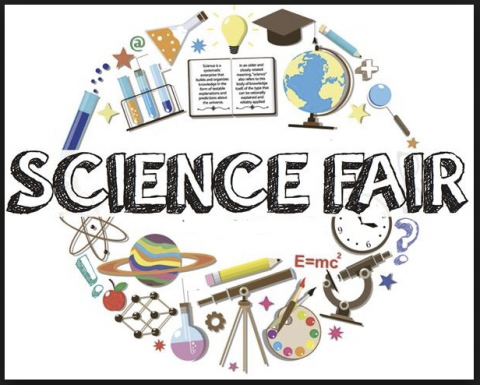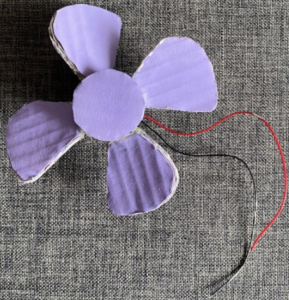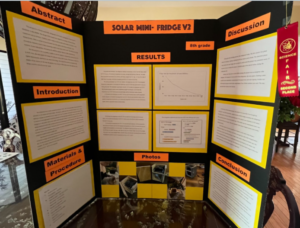
8th Grade Science Fair Winners
by Julia Shin
Congratulations to all of the Science Fair winners and good luck to all of the winners for County!
8th Grade
1st Place – Tanishga Thankaraj Vijay & Harshini Manikandan
Project Title: Determining Factors that Affect a Fan’s Performance


This fusion of an experiment and an engineering project was focused on determining which type of blade shape will generate the most voltage. Tanishga and Harshini created five common fan blades from cardboard and attached a bottle cap and a rod of a DC motor to the blades to complete the fan. Then, all of the five fans were positioned facing a house fan (maintaining equal distance and speed for each fan) as a multimeter measured the electricity generated. They discovered, the purple fan, as shown above, was the best design. As Tanishga and Harshini have an interest in the field of wind energy, they wanted to understand better how fans work, like the ones used in everyday life. From this project, they learned how the most important factors affecting a fan’s performance are the number of fan blades, the surface area, and the angle. Furthermore, they learned about the various fans and each of their unique purposes. Thus, they learned about the balance between having the least number of blades, however, not letting that comprise the loudness of the sound created by the fan or the fan’s effectiveness.
2nd Place – Jasper Mejia
Project Title: Solar Mini Fridge V2


This engineering project was inspired by Jasper’s mom, who’s a Type 1 diabetic. Being a diabetic, she requires insulin to survive. Thus, for emergency purposes, when electricity may be unavailable, this solar-powered mini-fridge stores and cools insulin for insulin to be useable (for the fridge to be successful, it much reach a temperature between 34.0˚F – 40.0˚F). Also, since the fridge is solar-powered, it eliminates using multiple batteries just once. As Jasper shared, he believes this project could help people around the globe who have pre-existing conditions. From this project, he learned about various techniques of heat transfer and how to use different insulators to counter each of those methods. For example, he used wood, foam, and aluminum since they are all materials used to stop the heat. Additionally, he learned about how to have a polished final project, many prototypes have to be created and constantly revised.
3rd Place – William Kim
Project Title: Detecting Ink Levels With Image Processing

The purpose of this engineering project was to create an efficient and easy-to-use indicator that notifies the user how much ink is left inside a pen. Before using the pen, the ink level is determined and shown to the user so the ink container does not have to be removed (yet, this prototype mostly requires taking out the ink container to use it). William chose this project because he believed being able to view how much ink is left in a pen is very practical for daily life and it would help numerous people. From this project, he shared he learned that image processing can be very useful and that other future technological developments can solve other various common problems.
Honorable Mention – Iden Stein & Jamieson Wong
Project Title: The Odds of Cheating in Blackjack

The purpose of this experiment was to stimulate methods to count blackjack cards and discover how much money people collected from their bets. As Iden shared, he believed, “creating a blackjack simulation that card counts tens of millions of hands in minutes is absolutely awesome.” From this project, Iden and Jamieson learned that in simulations, there aren’t big differences in different card counting methods yet in real life, there are big differences.
Read More
Lunar New Year
by Desmond Devine
Origin
Lunar New Year is celebrated by many cultures, including the Chinese New Year, and it begins with the first new moon of the year and ends with the full moon that occurs about fifteen days after the new moon. Every Lunar New Year is represented with one of twelve animals in the Chinese zodiac, each representing different personality traits. The signs repeat in a twelve year cycle. Each animal is also given the properties of one of five elements: earth, fire, metal, water, and wood. Each cycle of signs is given its own element, and the cycle of elements repeats itself every five sign cycles. This year is the year of the Water Tiger. The Water Tiger represents courage, strength, and the forces of good.

Chinese New Year
It is believed that Chinese New Year has been celebrated since the 14th century B.C., during the time of the Shang Dynasty. Around 100 B.C. was when the tradition of doing rituals on Chinese New Year began. The rituals served to honor the gods in hopes of a good harvest. The Chinese government led under Communist leader Mao Zedong ceased celebration of Chinese New Year in 1949. Towards the end of the 20th century, the government became more open to Chinese New Year celebrations and gave people a week off during a period known as the Spring Festival. Today people celebrate by being with their families, giving money to others in red envelopes, and eating traditional foods such as fish, dumplings, moon cakes, and rice ball soup. At the end of the celebration, the Lantern Festival occurs in which people light colorful lanterns to decorate their homes as well as participating in games, parades, and dances. Firework displays also celebrate the end of the Spring Festival. The lighting and letting go of the lanterns symbolizes letting go of people’s past transgressions.

Vietnamese New Year
Vietnam’s Lunar New Year is known as Tet Nguyen Dan and usually shortened to just “Tet”. It spans 5-7 days, beginning on the same day as Chinese New Year, and also marks the beginning of Spring. During this time, Vietnamese people give reverence to their ancestors and hold family reunions. People are mindful, believing that what they do during Tet will affect the rest of the year. Before Tet, families clean and decorate their homes, family shrines, and the graves of deceased family members. People light incense and leave offerings of fruit and flowers on the shrines along with pictures of ancestors, similar to the traditions of Día de los Muertos in Mexico. Traditional foods are enjoyed, such as banh chung, a ball of rice filled with meat or bean paste and wrapped in banana leaves, and xoi, Vietnamese sticky rice.

A picture of a dragon dance
Korean New Year
In Korea, Lunar New Year is known as Seollal and is celebrated similarly to Chinese New Year. When Japan annexed Korea from 1910 to 1945, Lunar New Year was officially stopped. Celebrations made a comeback in 1989, and the day of celebration shifted to occur based on the lunar calendar. Families participate in a ritual in which reverence is given to ancestors and the elderly. In both North and South Korea, traditional dishes include sliced rice cake soup, which marks a person’s Lunar Calendar Birthday upon consumption. Games are played, such as Yut Nori, a relay race where players move depending on how they throw colored sticks, which function similarly to dice.

A bowl of rice cake soup
Mongolian New Year
Lunar New Year is known as Tsagaan Sar in Mongolia and shares many characteristics with Chinese New Year. For example, it uses the same zodiac as China to name new years. It was created in 1206 under the rule of Chinggis Khan. On Bituun, the evening of the day before Lunar New Year begins, families gather at the home of the oldest member to have a feast and play games. On the first day, before the sun rises, people make milk tea and visit their elders. Traditional meals eaten during Tsagaan Sar include buuz, dumplings filled with minced beef or lamb, and ul boov, long biscuits stacked on plates. Since Tsagaan Sar feasts are large, families have to start cooking them days in advance.

A traditional Tsagaan Sar greeting, in which a person greets an old relative by placing their hands below the other’s arms and saying “Amar baina uu”, meaning, “How are you?”
Tibetan New Year
In Tibet, New Year is known as Losar and takes place on December 29th on the Tibetan lunar calendar. Celebrations last two weeks. It was created after the marriage of Princess Wencheng of Han and the King of Tibet, Songtsan Gampo in 641 AD, which united the two nations. In the streets people sing and perform dances and act out battles. The two days before the new year are called “Gutor”. On the first day, families clean their homes. On the second day, people perform religious ceremonies and give to charity. On the first day of New Year, families come together for a reunion dinner and give each other presents. On the second day, families visit their friends and relatives. On the third day, families visit monasteries and hang prayer flags on the tops of houses and along mountains. A traditional food eaten during Losar is guthuk, a soup with dumplings. The ingredients the chef puts in a person’s dumplings is a playful commentary on their personality.

Sources
https://www.britannica.com/topic/Lunar-New-Year
https://www.history.com/topics/holidays/chinese-new-year
https://people.howstuffworks.com/culture-traditions/holidays-other/billions-celebrate-lantern-festival-across-china.htm
https://www.britannica.com/topic/Lantern-Festival
https://asiasociety.org/korea/seollal-korean-lunar-new-year
https://www.asiahighlights.com/vietnam/new-year
https://www.itourvn.com/blog/a-look-into-vietnamese-lion-and-dragon-dance
http://nayazaya.blogspot.com/2019/01/the-tsagaan-sar.html

Black History Month
by Milan Riley
Black History Month is a national occasion celebrated during the month of February. This is a time to appreciate authors, inventors, political figures, scientists, and cultural leaders of African descent for their important contributions. The observance first began in the United States on January 2, 1970 and has been annually observed ever since. In addition, it is celebrated in Canada and the United Kingdom.
The Origin of Black History Month
The roots of Black History Month began with African American History Week. Historian Carter G. Woodson organized the first African American History Week in the second week of February to commemorate the achievements of Black Americans. He choose the second week of February to coincide with the birthdays of Abraham Lincoln and Frederick Douglass, who both contributed so much to the emancipation of African Americans. The event inspired schools and communities nationwide to organize local celebrations, establish history clubs, and host performances and lectures. Though the event transformed into Black History Month in 1970, it wasn’t official until 1976, when President Gerald Ford first recognized the observance.

Carter G. Woodson

Celebrated Individuals in Black History
Notable African American Figures
Rev. Martin Luther King, Jr.
Martin Luther King Jr. was an activist and peaceful protester for African American rights during the 1950’s and 60’s. As a Baptist minister, Martin Luther King Jr. also led the Southern Christian Leadership Conference. He was born on January 15, 1929 and was assassinated on April 4, 1968 after delivering his last speech, “I’ve Been to the Mountaintop” the preceding day. King’s most famous speech was made on August 28, 1963, called “I Have a Dream.” Martin Luther King, Jr. greatly contributed to the end of segregation through his support of the Civil Rights Act of 1964.

Martin Luther King. Jr delivering “I Have a Dream”
Rosa Parks
Rosa Parks was an American civil rights activist best known for her role in the Montgomery bus boycott. She initiated the movement by refusing to give up her seat to a white man on a Montgomery, Alabama bus in 1955, thereby helping to end segregation in public transportation. Rosa was born on February 4, 1913, and died on October 24, 2005. She received many awards such as the Congressional Gold Medal, Spingarn Medal, and the Presidential Medal of Freedom.

Rosa Parks on a bus in Montgomery, Alabama
Shirley Chisholm
Born in 1924, Shirley Chisholm ran for New York State Assembly in 1964 and became the first African American congresswoman when she was elected in 1968. Shirley continued to serve from 1969 to 1983 before becoming the first African American of a major political party to run for the Democratic party’s presidential nomination. Her well-known campaign slogan was “Unbought and Unbossed.” Of her legacy, Chisholm said, “I want to be remembered as a woman … who dared to be a catalyst of change.”

Rep. Shirley Chisholm
John Baxter Taylor, Jr.
Born on November 3, 1882, John Taylor was a record-setting athlete in track and field before he died on December 2, 1908. As a quarter-miler for his college, John set a world record of 49.1 seconds for the 440-yards in 1903. In 1907, John set a new record of 48.6 seconds in the same event and became the indoor champion for 600 yards. A year later, John Taylor became the first African American to win an Olympic Gold Medal after participating in the 1908 Summer Olympics Men’s medley relay.

John Baxter Taylor, Jr.
Hattie McDaniel
Hattie McDaniel started her entertainment career as a band vocalist in the 1910s and later debuted as an actress in The Golden West (1932). She was born on June 10, 1893 and died on October 26, 1952. Hattie was best known for her role as Mammy in Gone With the Wind (1939). Her performance earned the Academy Award for Best Supporting Actress that same year, making her the first African American to win an Oscar.

Hattie McDaniel receiving an Oscar
Guion Bluford
Guion Stewart Bluford Jr. is an American aerospace engineer, retired U.S Air Officer and fighter pilot, as well as a former NASA astronaut. Guion was born on November 22, 1942, and is currently 79 years old. He flew 144 combat missions during the Vietnam war and was one of the 10,000 applicants selected by NASA’s competition to become space shuttle astronauts. On August 30, 1983, he became a crew member of the STS-8 mission and the first African American to go to space. Afterwards, Guion completed missions STS-61A, STS-39, and his last journey, STS-53, on December 2, 1992. Guion was awarded the Air Medal and the NASA Distinguished Service Medal.

Guion Bluford in space
Read More
